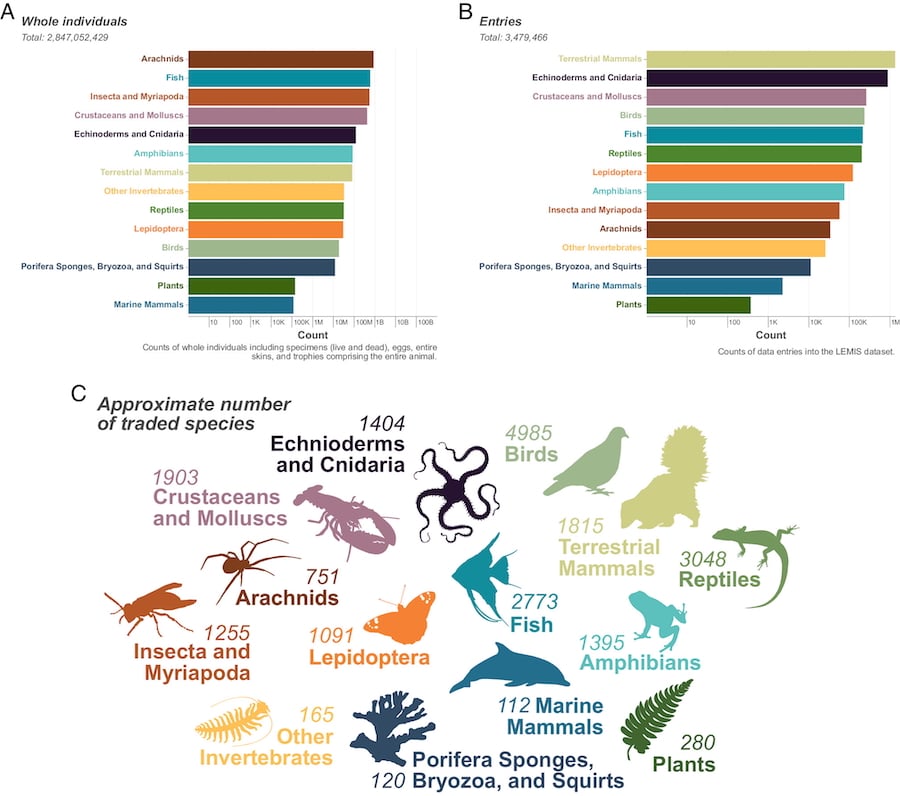This post was originally published on Eco Watch
New international research has found that nearly 30,000 wild animal species have been traded throughout the United States, according to data from the U.S. Law Enforcement Management Information System (LEMIS), a wildlife trade monitoring organization maintained by the U.S. Fish and Wildlife Service.
Led by University of Hong Kong (HKU), the analysis looked at 22 years of trade data involving over 2.85 billion individual animals, half of them taxa taken from the wild, a press release from University of Adelaide said.
“The United States is one of the world’s largest wildlife importers and is unique in documenting trade in species not covered by international regulation,” said Freyja Watters, a Ph.D. student with the Wildlife Crime Research Hub at University of Adelaide, in the press release. “We uncovered tens of thousands of wild species and billions of individual animals entering trade, most without any global oversight.”
The researchers also discovered that just a small fraction — not even 0.01 percent — of wildlife in trade was illegal, emphasizing the necessity for reforms to provide better protection for more species.
“Current international regulations focus on only a fraction of wildlife, often biased toward charismatic species. Although most of this trade is legal, the majority of species are not subject to assessments ensuring sustainable harvest,” Watters said in the press release. “This reveals a major gap in our ability to measure the true impact of wildlife trade and underscores the need for stronger global monitoring and management.”
The U.S. is one of the largest wildlife traders on the planet, but it is a worldwide problem. Wildlife in trade is one of the biggest threats to many species’ survival. An assessment by the Intergovernmental Science-Policy Platform on Biodiversity and Ecosystem Services has said that 50,000 species are in trade globally.
“While we can monitor the number of species and individuals coming into the U.S., comparable data is not available for anywhere else in the world,” said leader of the study Dr. Alice Catherine Hughes, an associate professor in the School of Biological Sciences at HKU, in the press release. “For most species in trade, as we have no data on offtake or wild populations, we cannot assess sustainability of that trade. However, where assessments have been made, the majority of populations where harvest was occurring have shown declines.
The study, “The magnitude of legal wildlife trade and implications for species survival,” was published in the journal Proceedings of the National Academy of Sciences.
Overview of species and quantities traded in the LEMIS. (A) Totals of whole individuals measured by count. (B) Total number of entries. (C) Approximate counts of species traded. Note that the x axis is logarithmic. PNAS
“This research has advanced our understanding of trade, and the codes developed will also enable the standardisation and analysis of further trade data,” Hughes said. “But we have also highlighted how little is known about what makes up wildlife trade, showing that the lack of systematic monitoring undermines any ability to understand or monitor trade, precluding any opportunity to manage it sustainably.”
Additional global wildlife trade research is forthcoming.
“We hope that our ongoing research will encourage nations to assess how their wildlife trade data is recorded and shared, as without more comparable global data we cannot assess the impact of trade on the majority of traded species,” said professor Phill Cassey, director of the Wildlife Crime Research Hub, in the press release.
The post Nearly 30,000 Unregulated Wild Animal Species Traded in the U.S., Researchers Find appeared first on EcoWatch.




0 Comments